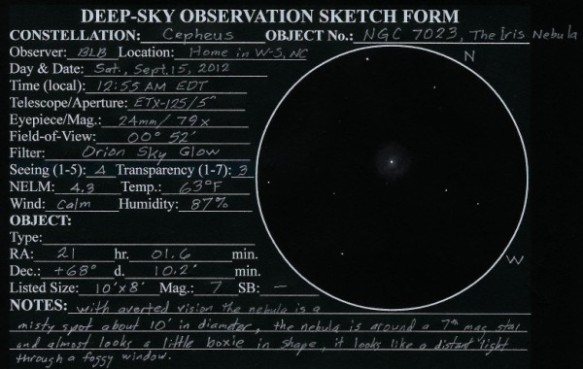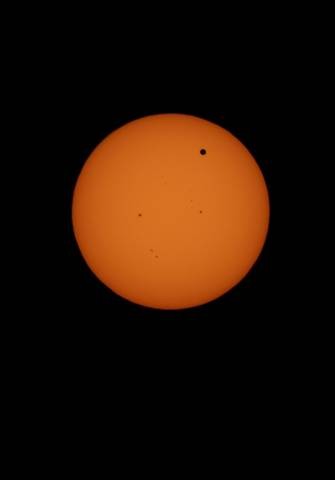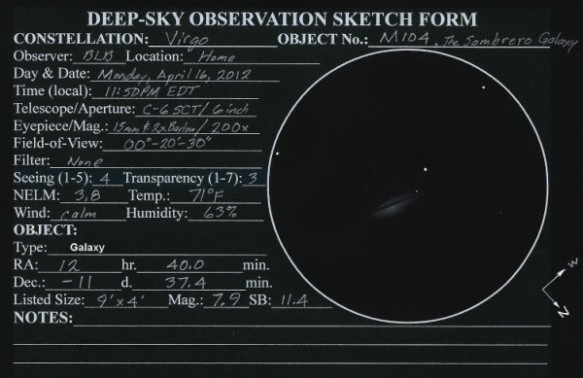Deep-Sky Objects Contained in the book
In Starland with a Three-Inch Telescope
By: William Tyler Olcott
Published in 1909
There have been several people who have compiled a list of the double stars that Olcott included in the book “In Starland with a Three-inch Telescope.” This is a good list to work your way through for those interested in double stars. Then someone on Yahoo’s 60mm telescope club web page recently suggested observing the list of deep-sky objects in this book as an observation list, but I have never seen these objects put into a list, so I thought I would give it a try.
When I started going through my copy of this book, I became aware that the numbers used for these objects were not the familiar NGC numbers. My problem was trying to figure out what numbering system Olcott used for the clusters and nebula he included. Remember that in 1900 everything in the sky was either a nebula or a cluster, there were no galaxies yet. I had always assumed that these numbers were NGC numbers. It turns out that they are General Catalog (GC) numbers, the predecessor of the New General Catalog (NGC). I now have it figured out and have converted these GC numbers to their equivalent NGC numbers for a possible observing project.
The list turns out to be a strange mix of objects. There are only 41 Messier objects included and there are 44 NGC objects included too for a total of 85 nebula and clusters in Olcott’s list. I started to wonder why he included the objects he did and left out some really bright objects near other objects he included. For example he included M80 in Scorpius, a small dim globular to me, and left out M4, which is resolvable, and he also missed the bright clusters M6 and M7 which from a dark sky are naked eye objects. Another example, he includes Tuttle’s variable nebula, NGC 6643 (mag. 11.5) in Draco and left out the bright Cat’s Eye Nebula, NGC 6543. He includes NGC 2903 & 2905 in Leo but nothing of M65, M66 or M95, M96 and M105. If I recall correctly, Olcott entered into astronomy only four years before he wrote In Starland with a Three-inch Telescope. So I think this has more to do with information not being readily available in the early 1900’s and the fact that he had only been observing for four years when he wrote the book. He may have included all the objects he had seen at that time and nothing else. That explains for me the limited and spotty coverage of this list.
The first column in this list is the now familiar NGC or IC number for each object followed by the General Catalog number and the Messier number where applicable. I have listed next what we know each object to be today. For Olcott, each object was listed as a nebula, cluster and a few as globular clusters. The boundaries of the Constellations were not set when Olcott prepared his list of objects so I have shown the constellation each object is located in today, which is not always the same constelation that they are shown to be located in in Olcott’s book. This is followed by the integrated magnitude for each object and it’s listed size. Last I have shown the common name for each of the objects that have them.
I hope you enjoy observing this list as much as I did preparing it.
NGC No. GC No. M Type Const. Mag. Size
129 63 – OC Cas 6.5 21
224 116 31 Gx And 3.6 192’x62′ The Andromeda Galaxy
225 120 – OC Cas 7.0 12′ The letter “w” cluster
253 138 – Gx Scl 7.8 27’x7′ The Sculptor Galaxy
457 256 – OC Cas 6.4 13′ The Airplane/Owl/ET Cluster
524 307 – Gx Psc 10.5 3′
598 352 33 Gx Tri 5.8 71’x42′ Pinwheel or Triangulum Galaxy
663 392 – OC Cas 7.1 16′
752 457 – OC And 5.7 50′
869 512 – OC Per 5.3 29′ Part of Double Cluster
884 521 – OC Per 6.1 29′ Part of Double Cluster
1039 584 34 OC Per 5.2 35′
1245 658 – OC Per 8.4 10′
1342 717 – OC Per 6.7 14′
1513 809 – OC Per 8.4 9′
1528 820 – OC Per 6.4 23′
1535 826 – PN Eri 9.6 48”x42” Cleopatra’s Eye
1545 831 – OC Per 6.2 18′
1662 905 – OC Ori 6.4 20′
1778 996 – OC Aur 7.7 6′
1817 1030 – OC Tau 7.7 16′
1857 1067 – OC Aur 7.0 5′
1893 1101 – OC Aur 7.5 11′ Associated with Nebula
1904 1112 79 GC Lep 7.7 9′
1912 1119 38 OC Aur 6.4 21′
1952 1157 1 SNR Tau 8.4 6’x4′ Crab Nebula
1960 1166 36 OC Aur 6.0 12′
1976 1179 42 BN Ori 4.0 90’x60′ The Great Nebula in Orion
1981 1184 – OC Ori 4.2 25′
2099 1295 37 OC Aur 5.6 23′
2168 1360 35 OC Gem 5.1 28′
2169 1361 – OC Ori 5.9 6′ The “37” Cluster
2194 1383 – OC Ori 8.5 10′
2244 1424 – OC Mon 4.8 24′ Cluster in the Rosette Nebula
2281 1451 – OC Aur 5.4 14′
2287 1454 41 OC CMa 4.5 38′ The Little Beehive
2318 1479 – OC? CMa – – Sparse group, NOT a cluster
2359 1511 – BN CMa – 10’x5′ Thor’s Helmet or Duck Nebula
2420 1549 – OC Gem 8.3 10′
2548 1637 48 OC Hyd 5.8 54′
2632 1681 44 OC Cnc 3.1 95′ The Praesepe or Beehive Cluster
2682 1712 67 OC Cnc 6.9 29′
2903 1861 – Gx Leo 9.0 12’x6′
2905 1863 – Gx Leo – – The northeast arm of galaxy 2903
3031 1949 81 Gx UMa 7.3 27’x14′ Bode’s Nebula
3034 1950 82 Gx UMa 8.9 11’x5′ Cigar Galaxy
3166 2038 – Gx Sex 10.4 5’x2′
3169 2041 – Gx Sex 10.7 4’x3′
3242 2102 – PN Hya 7.7 45”x36” Ghost of Jupiter
3587 2343 97 PN UMa 9.9 3.4′ Owl Nebula
3800 2488 – Gx Leo 12.9 2’x0.6′
4361 2917 – PN Crv 10.9 2′
4762 3278 – Gx Vir 10.0 9’x2′
5194 3572 51 Gx CVn 8.5 11’x8′ Whirlpool Galaxy
5272 3636 3 GC CVn 6.3 18′
5904 4083 5 GC Ser 5.7 23′
6093 4173 80 GC Sco 7.3 9′
6171 4211 107 GC Oph 7.8 10′
6205 4230 13 GC Her 5.8 17′ The Great Hercules Cluster
6254 4256 10 GC Oph 6.6 15′
6273 4264 19 GC Oph 6.8 14′
6284 4268 – GC Oph 8.9 6′
6287 4269 – GC Oph 9.3 5′
6293 4270 – GC Oph 8.3 8′
6341 4294 92 GC Her 6.5 14′
6402 4315 14 GC Oph 7.6 12′
6494 4346 23 OC Sgr 5.5 30′
6514 4355 20 BN Sgr 6.3 20′ The Trifid Nebula
6523 4361 8 BN Sgr 5.0 45’x30′ The Lagoon Nebula
6603 4397 – OC Sgr 11.1 5′ OC in M24, small Sag. Star Cloud
6613 4401 18 OC Sgr 6.9 9′
6618 4403 17 BN Sgr 6.0 20’x15′ The Swan, Checkmark or Omega
6643 4415 – Gx Dra 11.5 4’x2′
6656 4424 22 GC Sgr 5.2 24′
6709 4440 – OC Aql 6.7 13′
6720 4447 57 PN Lyr 8.8 86”x62” The Ring Nebula
6838 4520 71 GC Sge 8.4 7′
6853 4532 27 PN Vul 7.4 8’x6′ The Dumbbell or Apple Core Neb.
7009 4628 – PN Aqr 8.0 44”x23” The Saturn Nebula
7078 4670 15 GC Peg 6.3 12′
7089 4678 2 GC Aqr 6.6 13′
7092 4681 39 OC Cyg 4.6 31′
7099 4687 30 OC Cap 6.9 11′
7789 5031 – OC Cas 6.7 25′
IC4725 – 25 OC Sgr – 32′








